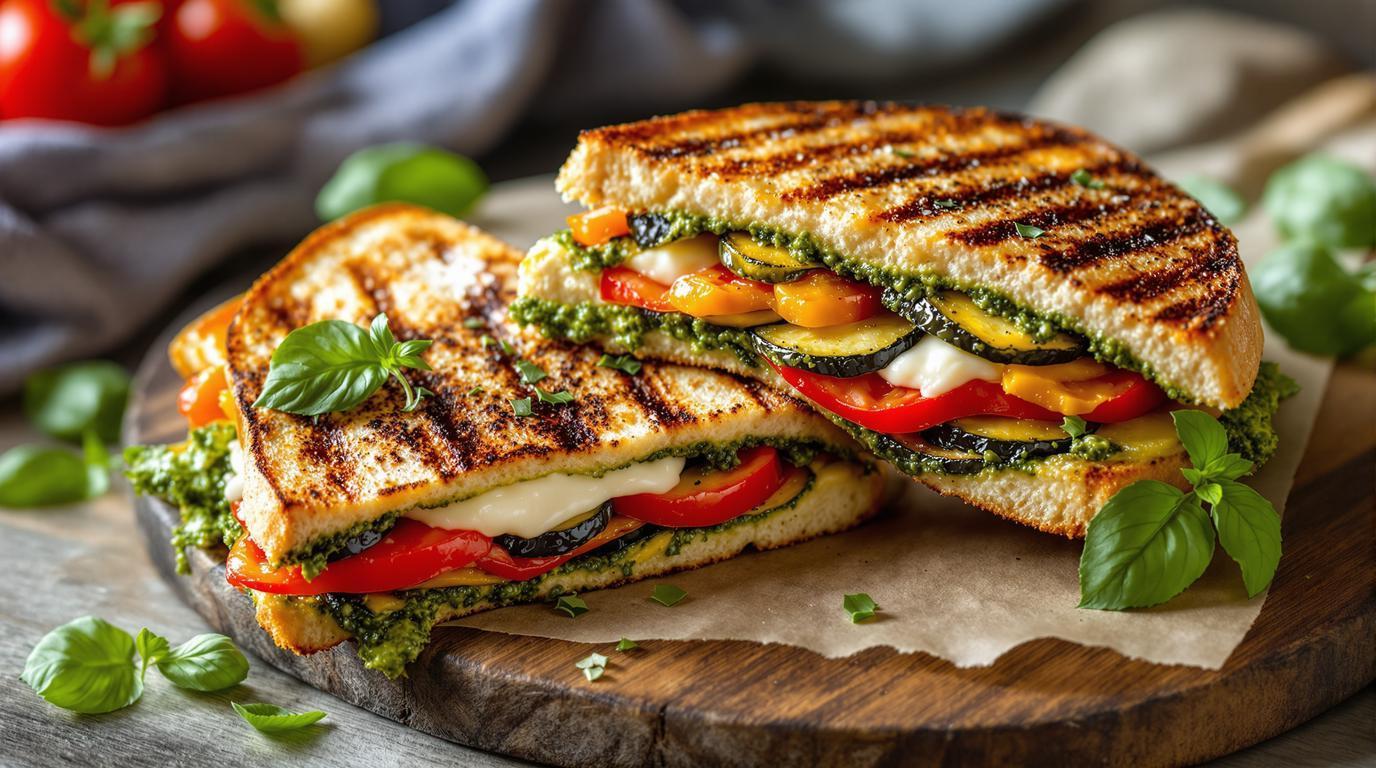The first time I made grilled vegetable panini with pesto was during a sweltering summer in Liguria, Italy. I was apprenticing under an 80-year-old chef named Nonna Lucia who insisted that the secret to perfect panini wasn’t in fancy equipment, but in the unhurried marination of vegetables and the careful pressing of the sandwich. “Pazienza,” she would say with a knowing smile. “Patience transforms ordinary ingredients into something magical.” Twenty years later, I still follow her method, allowing the vegetables to marinate before grilling them to smoky perfection. The aroma of fresh basil pesto still transports me back to that tiny Italian kitchen where I learned that the most humble ingredients often create the most memorable meals.
The Story Behind Grilled Vegetable Panini with Basil Pesto 📖
This sandwich embodies the essence of Northern Italian summer cuisine, particularly from Liguria, the birthplace of pesto. Unlike many modern interpretations, traditional panini weren’t always pressed—they began as simple bread and fillings before evolving into the golden-crisp, cheese-melting delights we recognize today. What makes this version special is the marriage of slow-grilled vegetables with the bright, herbal intensity of freshly made pesto—a combination that honors centuries-old Mediterranean flavor pairings while offering satisfying texture contrasts between crispy bread, silky cheese, and tender vegetables.
Essential Ingredients 🧾
For 4 panini, you’ll need:
For the vegetables:
• 2 medium zucchini, sliced ½” thick (about 1 pound/450g)
• 1 large eggplant, sliced ½” thick (about 1 pound/450g)
• 2 red bell peppers, seeded and sliced into ½” strips
• 2 tablespoons extra virgin olive oil
• ½ teaspoon sea salt
• ¼ teaspoon freshly ground black pepper
For the pesto:
• 2 cups fresh basil leaves, packed (about 2 oz/60g)
• ¼ cup toasted pine nuts (2 oz/60g)
• 2 garlic cloves, peeled
• ½ teaspoon sea salt
• 6 tablespoons extra virgin olive oil
• ½ cup freshly grated Parmigiano-Reggiano (1.5 oz/45g)
For assembly:
• 1 loaf ciabatta or rustic Italian bread, cut into 4 sections and split horizontally
• 12 ounces fresh mozzarella, sliced (340g)
• Extra olive oil for brushing
Chef’s Note: If pine nuts are unavailable or beyond your budget, walnuts make an excellent substitute in pesto. They offer a different but equally delicious richness. For a sharper flavor profile, replace the mild mozzarella with aged provolone—a variation you’ll find more commonly in Tuscan interpretations of this sandwich.
Step-by-Step Instructions 📝
1. Marinate the vegetables: In a large bowl, toss the sliced zucchini, eggplant, and bell peppers with olive oil, salt, and pepper. Allow them to rest for 30 minutes—this critical step prevents bitterness and ensures even cooking.
2. Prepare the pesto: While the vegetables marinate, combine basil, pine nuts, garlic, and salt in a food processor. Pulse until coarsely chopped. With the processor running, slowly drizzle in the olive oil until the mixture is smooth but still has some texture. Add the Parmigiano-Reggiano and pulse just until incorporated. The pesto should be vibrant green and fragrant.
3. Grill the vegetables: Heat a grill pan or outdoor grill to medium heat (about 350°F/175°C). Grill the vegetables in batches, about 4-5 minutes per side, until they develop beautiful char marks and become tender. Transfer to a plate and allow to cool slightly.
4. Assemble the panini: Brush the outside of each bread section with a little olive oil. Spread about 1 tablespoon of pesto on the inside of each bread piece. Layer the grilled vegetables and mozzarella slices on the bottom halves, then top with the remaining bread.
5. Press and cook: Heat a panini press to medium heat. Cook the sandwiches for 4-5 minutes until the bread turns golden and crispy, and the cheese melts completely. If you don’t have a panini press, use a heavy skillet to press the sandwiches while cooking in another pan.
Chef’s Secret Techniques 🤫
The difference between a good panini and an extraordinary one lies in technique. First, never skip the vegetable marination—this prevents the bitter taste that can come from grilled eggplant and zucchini. Second, when making pesto, add the cheese last and pulse minimally; overprocessing with cheese creates a gummy texture rather than the silky-yet-textured sauce we want.
When pressing your panini, apply firm but gentle pressure. Too much force will crush the filling out the sides; too little will result in an unevenly crisped exterior. The ideal temperature creates a golden crust while allowing enough time for the cheese to melt completely—about 350°F (175°C) is perfect.
Serving & Presentation Tips 🍽️
Slice each panini diagonally to showcase the beautiful layers of vegetables and melted cheese. Serve immediately while the contrast between crispy exterior and warm, melty interior is at its peak. A perfect pairing is a glass of chilled Vermentino—its bright acidity cuts through the richness of the cheese and complements the herbal notes in the pesto.
For a complete meal, serve alongside a simple green salad dressed with lemon and olive oil or a small bowl of marinated olives. The beauty of this sandwich lies in its rustic elegance—no elaborate garnishes needed, just honest ingredients prepared with care.
Remember what Nonna Lucia taught me years ago: the humble panini isn’t just lunch—it’s a celebration of summer’s bounty, transformed through patience and technique into something truly special. Let the ingredients speak for themselves, and you’ll create not just a meal, but a memory worth savoring.
